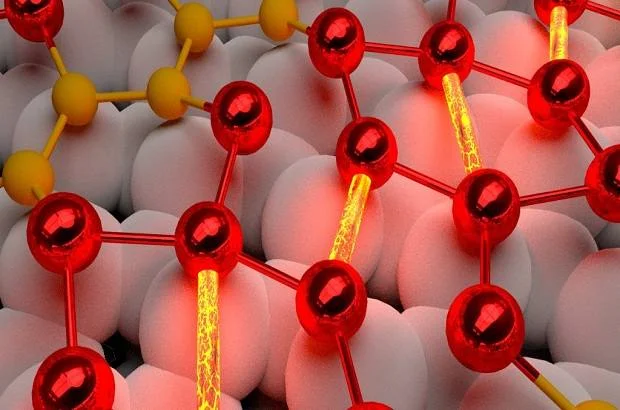 |
| Electron behavior during chemical reactions- Credit: Andreas Lücke |
Researchers
use supercomputing simulations and laser pulses to monitor electron behavior
during chemical reactions for the first time
Using supercomputing simulations and laser pulses, researchers of the Fritz Haber Institute Berlin and the University of Paderborn have demonstrated their ability to observe movements of electrons during the chemical reaction. Researchers have long studied nuclear-scale processes that control chemical reactions, but in the past, they were not able to observe the electron motions as they happened.Electron behavior during chemical reactions
Electrons are present on the smallest scales, which are less than a quarter of a meter in diameter and orbiting an atom with femtosecond speed. Experts interested in observing electron behavior use laser pulses to interact with electrons. They can calculate the energy and speed of electrons by analyzing the properties of electrons carried out by the laser light.
The challenge for researchers is to record events that occur on a femtosecond scale - they must first trigger a laser pulse system, then watch the next few femtoseconds. They then send a second laser pulse with a short delay of time for a few femtoseconds. Achieving this level of resolution is very difficult, as femtoseconds are too short - light can travel 300,000 kilometers in one second, but there are only 300 nanometers in one femtosecond.
After being excited with the first pulse of a laser, the valence electrons of the atoms - the electrons on the outer part of the atom that is likely to help form chemical bonds - may rearrange to form new chemical bonds, leading to new molecules. Because of the speed and magnitude of these interactions, however, the researchers only assumed how these rearrangements were made.
In addition to experimental techniques, high-performance computing (HPC) has become an increasingly important method to understand these interactions at the atomic level, verifying experimental observations, and studying electron behavior during the chemical reactions in more detail.
In order to better understand the behavior of electrons during a chemical reaction, Schmidt and his collaborators used supercomputing resources at the HLRS to illustrate this phenomenon. The experimental group has done the simulation. In the case, the theory was ahead of the experiment, as they predicted and confirmed it by the experiments.
Laser-like focus
The previous year, Schmidt's group participated in stimulating an atom-scale system with the experimentalists of Duisburg-Essen University and inspecting photo-induced phase transition (PIPT) in real-time. Phase transitions - When a substance changes from one physical state to another, such as changing the water into ice – are very important in the study and design of the material, because the properties of the substance can be wildly changed depending on that condition.
For example, the team found that when a laser is stimulated with the pulse, then indium-based nanoscale wires will be essentially converted into an electrical conductor from an insulator. In the absence of immediate technical interest for electronic applications, these indium wires work as a good test case and there is a solid foundation for verification of simulations with experiments.
This year, the team wanted to know what was learned about the indium wires and studied chemical reactions at a more fundamental level - wanted to track how the constituent electrons behave after being excited by laser pulses.
“Last year, we published a Nature article in which the measure of nuclear agitation was displayed on this scale. We could explain how the atom went through during the chemical reaction. This year, we were able to monitor electrons while the reaction was done,” Schmidt said.
In practice, electrons work in the form of glue that chemically binds the atoms together. However, a laser pulse can take out an electron, from which researchers can call "photo holes". These photo holes only last for many femtoseconds, but they lead to the breakdown of chemical bonds and the formation of new bonds. When indium nanowire is stroked with a laser pulse, the system creates a metallic bond, which changes its phase into an electrical conductor.
Supercomputing simulation allows researchers to keep the path of electrons in motion, eventually helping them to study the full response “pathway ". Researchers run the first-principle simulation, which means they do not make any assumptions about how the atomic system works, the experimental models of atoms and their electrons make models in experimental conditions. The supercomputing resources required to calculate this type of intensive as the first principles provided, at HLRS, through the Gauss Center for Supercomputing. Between its former work and its current project, the team now understands a better role how energy is distributed in a photo hole system, eventually, giving researchers a reliable computational method, with which very fast phase infections can be emulated.
Complex Chemistry
The current simulation of the team consists of approximately 1,000 atoms, which, while shorter, allows them to get a representative sample as to how interactions between the atoms of a system and their constituent electrons occur. The Paderborn group received help from the HLRS team in optimizing its code, which would allow it to run efficiently up to 10,000 cores in parallel. Schmidt explained that when overall research will benefit from increasing system size in the order of 10,000 atoms, the next step of the team is to work on more complex systems.
Current research is a complex calculation, but a simple system. The next step of the researchers is to develop this research because it is related to photocatalysts or systems that are massively relevant to the production of energy - they want to apply it to a real system. "To better understand the behavior of electrons at the atomic level, the researchers have the goal to create better materials for transporting, converting and storing energy.
Journal Reference:
Science, 2018; 362 (6416): 821 DOI: http://dx.doi.org/10.1126/science.aar4183
Tags
electronics
laser pulses
laser technology
latest technology trends
quantum-physics
supercomputers
